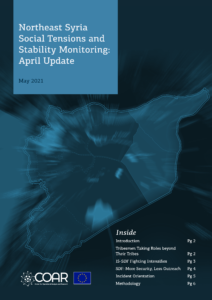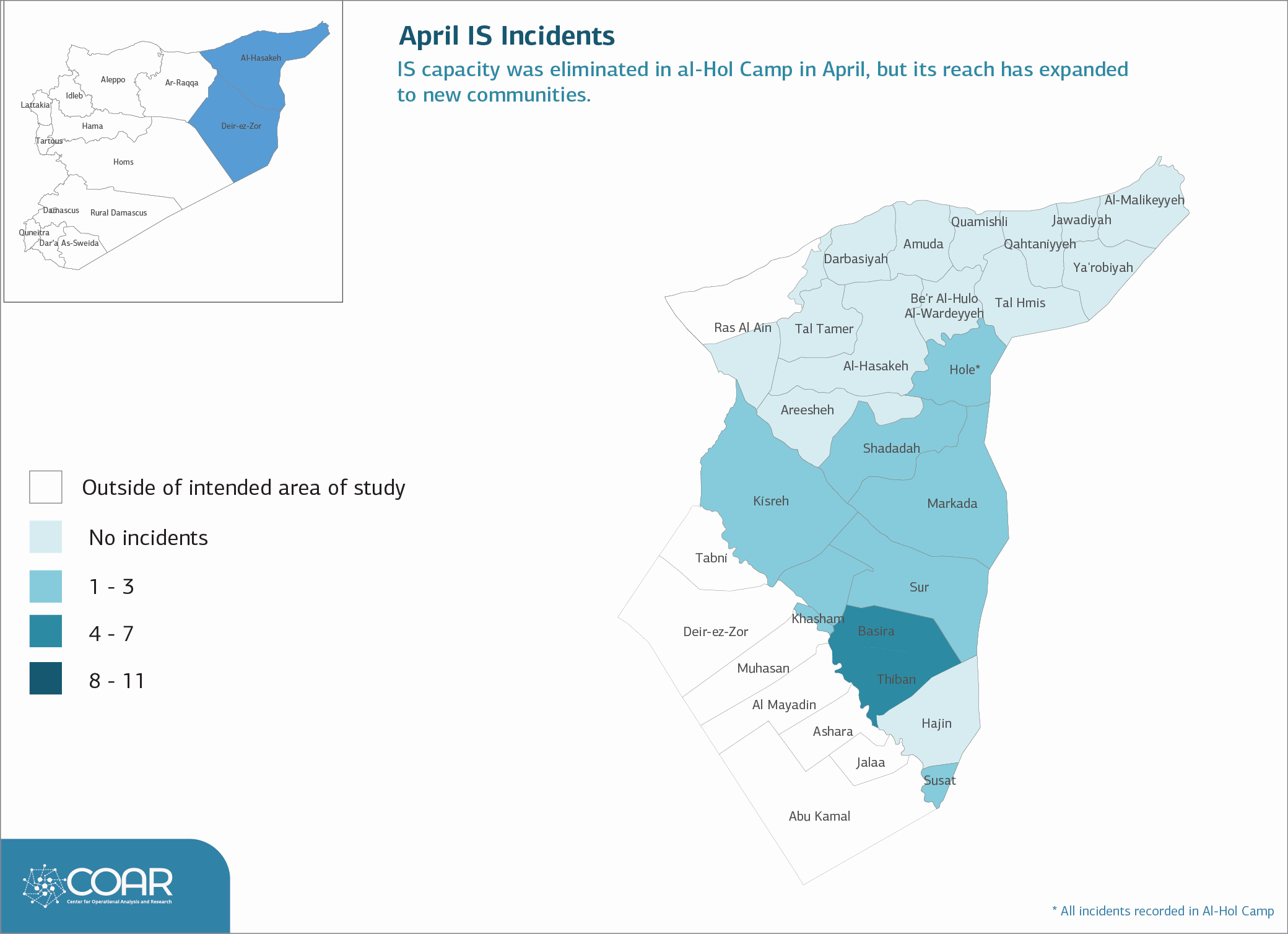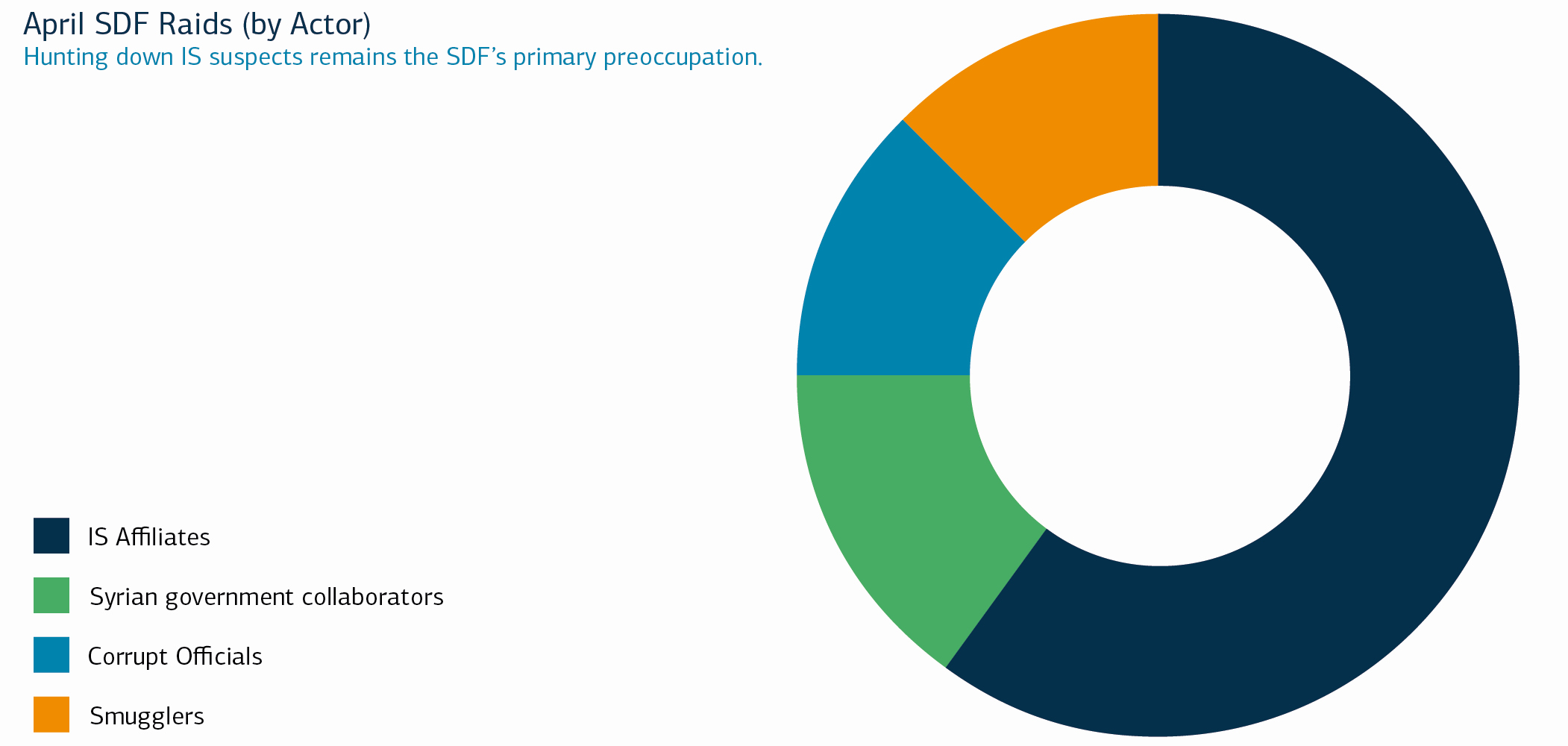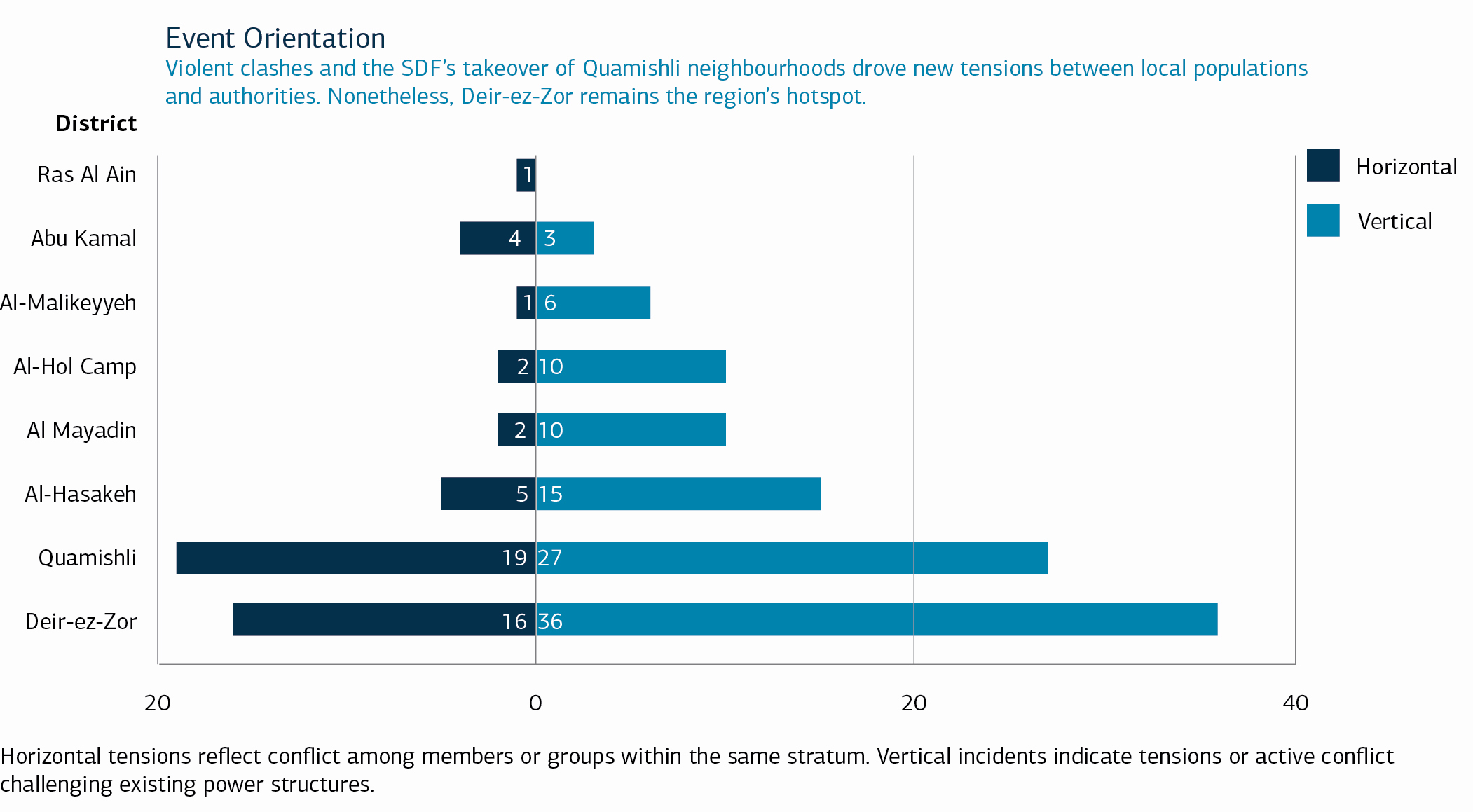[dflip id="55533"][/dflip]
Introduction
This is the second report in an ongoing pilot study by COAR to monitor stability and social tensions in northeast Syria. Data collected and verified by COAR field researchers has been classified and analysed according to a broad set of indicators. This brief report assesses data collected in April 2021. As with the previous assessment of March data (see: Northeast Syria Social Tensions and Stability Monitoring Pilot Project – March), this report breaks down three overarching dynamics: Arab tribes’ struggle to exert local autonomy; Islamic State (IS) insurgency; and the security-driven local engagement strategies of the Autonomous Administration and Syrian Democatic Forces (SDF).
In its totality, this project sets out to identify and observe the most relevant factors now shaping the operational environment for donor-funded aid activities, stabilisation initiatives, and political and strategic decision-making concerning northeast Syria. As active conflict in Syria slows and zones of control harden, it will become increasingly important for international relief and non-humanitarian initiatives to grapple with the local and regional conflict-drivers that this project aims to assess.

Tribesmen Taking Roles beyond Their Tribes
While incidents involving Arab tribes in March were predominantly related to local tensions among tribal actors within the same tribe, April events saw a different pattern of events in Al-Hasakeh and Deir-ez-Zor, leading tribal leadership to take on roles beyond their usual purview.
Quamishli Takeover Tests Tayy Loyalties
Clashes between the SDF and the Government of Syria-aligned National Defense Forces (NDF) in Quamishli city accounted for the majority of the events recorded in April, following a checkpoint confrontation that escalated into a full-scale siege and SDF takeover of several neighbourhoods (see: Syria Update 26 April 2021). These confrontations have significant military and social implications, given that the vast majority of NDF members in Quamishli belong to the Tayy tribe, the dominant Arab tribe in the district. Although the clashes did not provoke a wider inter-tribal or wider Arab-Kurd dispute — two pronounced fault lines in the area — tribal actors did play a role in mobilisation and mediation on both sides. Some Tayy tribesmen declared support for the Government of Syria, while others came out in favour of the Autonomous Administration. It may prove fateful that declarations of overt political affiliation in Quamishli are influenced to a large degree by geography. For example, branches of the Tayy tribe located within the SDF-controlled areas north of Quamishli are generally affiliated with the SDF, while those in the neighbourhoods and villages to the south are largely affiliated with the Government of Syria. Those residing in previously Government-controlled territory, including members of the NDF, will face greater political pressure owing to the SDF’s capture of that area. Any changes in their affiliation will evidence the degree to which tribal political leanings are malleable, potentially superficial, and a pragmatic response to ground realities. At the same time, continuing resistance to the SDF remains likely.
Faltering Mediation, and Resistance to the SDF
In Deir-ez-Zor Governorate, the hostile relationship between the SDF and Arab tribes continues to shape local politics and complicate the operational environment in key programmatic areas along the Euphrates River. Two dominant trends have emerged in recent months. First, confrontation has seemingly trumped mediation, as efforts by leading tribal figures in Shiheil to contain escalation following the shooting of an SDF patrol have failed. This is despite meetings with the Deir-ez-Zor Military Council and with high-ranking SDF commanders at the military base in the al-Omar oil field. The second main theme is the continuing push for independent agency outside the remit of the SDF (a theme also brought to the surface by the Quamishli clashes). For instance, the Council of Abu Kamal Tribes-Jazeera issued a statement on 6 April repudiating the authority of the SDF-backed Deir-ez-Zor Civil Council and demanding greater independence for tribes in the governorate. Another statement, issued by leaders of the Ez-Edden tribe (which belongs to the Al-E’keidat tribal confederation), condemned the marginalisation of the tribe and called for the establishment of a new council to further its representation. In Zghir Jazireh (Kisreh), several members of the Bakkara tribe, including the local mukhtar[1], were detained by the SDF on the pretext that they were recruiting individuals to join local, Syrian Government-funded armed resistance units to undermine the SDF.
Notably, the number of recorded tribal meetings decreased over the last month (only three meetings in April compared to eight in March). Only one major mediation took place in Al-Hasakeh Governorate in Big Dalawiya (Al-Hasakeh), following a dispute between two families of the Rashid Tribe (Tayy) over a land use issue. It is worth noting that the meeting was led by Humaydi Daham al-Hadi, head of the Shammar tribe and Joint President of the Syrian Democratic Council. On the international level, after attending several meetings with local figures in Deir-ez-Zor, the Deputy U.S. Special Envoy for Syria met with tribal leaders in Al-Malikeyyeh to discuss the tribal situation in the region. Though important signs of intent, such meetings have seldom brought forward material responses to the entrenched grievances frequently vocalised by tribal leaders.
IS-SDF Fighting Intensifies
As in March, IS remains the main driver of insecurity in the area under study, although its activity has markedly decreased in a key area of international concern, the overpopulated al-Hol Camp. The SDF arrested approximately 125 suspected IS affiliates over the course of its sweeping “Humanity and Security” campaign targeting the camp (see: Syria Update 6 April 2021). Although the ensuing reduction in violent incidents may prove temporary, it is notable that only one IS-linked attack was recorded inside the camp during the whole of April. However, IS’s capacity appears undiminished in other areas of northeast Syria, and there was a slight increase in attacks linked to the group in April (18) compared to March (17). Eastern rural Deir-ez-Zor, in particular Thiban and Basira, remain the areas where the majority of security incidents linked to IS occur, often in the form of small-scale hit-and-run attacks primarily carried out at night by unknown individuals (generally one or two men on a motorcycle).

These attacks have two main characteristics with potentially far-reaching implications for future regional security, IS resurgence, and the operational environment of northeast Syria. First, they exclusively target the SDF (i.e. the group’s, its military outposts, and its checkpoints) and the Autonomous Administration (both formal affiliates and local interlocutors). Second, they generally avoid causing harm to civilians or other collateral damage. This is likely due to shifts in strategy and objectives by IS at the local level. Though not a wholly new phenomenon, the group has apparently sought to capitalise on the hostile relationship between local communities and the SDF in order to grow its popularity among marginalised Arab communities. For instance, the Deir-ez-Zor Civil Council, which has a notably poor local reputation among and has been widely accused of corruption, was one of IS’s main targets in April. On the whole, the pattern of attacks evidence what may be seen as IS’s gradual transition into a local insurgency. Whether this represents a concrete transformation or merely an opportunistic rebalancing of the group’s organisational structures, identity, and capacities remains to be seen. Certainly, as the group slowly rebounds, a growth in its organisational strength inside Syria will have security implications abroad, particularly in neighbouring countries.
SDF: More Security, Less Outreach
April incident data suggests that the SDF continues to grapple with security in the face of a growing need for outreach. Of incidents involving the SDF, 70 percent (64 incidents) were clashes with local actors and security campaigns, while less than 5 percent of incidents were meetings with local actors. In general, four main security concerns preoccupied the SDF: IS insurgency, smuggling, local corruption, and clashes with the NDF.
As noted above, although IS activities were dramatically reduced in al-Hol Camp, IS cells remained active elsewhere, including Deir-ez-Zor, where SDF and Autonomous Administration figures are the main targets of assassination attempts. The SDF arrested at least 62 suspected IS members. Two thirds of the arrests took place in Deir-ez-Zor (mostly in Thiban and Basira), while only four were recorded in Al-Hasakeh (Markada). Unusually, the majority of these arrests were supported directly by the U.S.-led International Coalition, which may suggest either that the targeted individuals were especially prominent, or that the SDF itself had limited capacity — or both. In multiple instances, more than one member of the same family was arrested, which lends further credence to the theory that IS recruitment and sympathies are increasingly localised.
Smuggling across the Euphrates River into Government-controlled areas was also a major target of SDF security actions in April. On five separate occasions, the SDF interdicted smuggling operations in Shiheil and Thiban and confiscated goods (flour or fuel). These incidents may have greater salience in political terms than as security incidents, as the SDF often halts smuggling activities to gain leverage over the Syrian Government or to pressure the local communities. A considerable number of residents in eastern rural Deir-ez-Zor are economically reliant on smuggling activities (especially in Shiheil), making any interruption a significant source of tension between the local population and the SDF.
Approximately ten arrests targeted members of the Autonomous Administration accused of corruption, including two high-ranking personnel of the Deir-ez-Zor Civil Council. As previously noted, corruption has been a major catalyst of local dissent and popular mobilisation against the Autonomous Administration and the SDF, even in Kurdish communities. So far, such arrests have proven ineffective at quieting local dissent. In parallel, a number of Autonomous Administration employees were arrested on the pretext of collaborating with the Government of Syria. In addition, with IS expanding its recruitment base and the Syrian Government and Turkey reaching out to disaffected local actors (see: Tribal Tribulations: Tribal Mapping and State Actor Influence in Northeastern Syria), the Autonomous Administration finds itself in a difficult position. It is obliged to fight corruption in order to preserve its constituencies and restore its legitimacy, yet its reach in trouble spots such as rural Deir-ez-Zor is often brokered through powerful local actors whose reputations are far from unblemished.

Incident Orientation
As in March, the predominance of vertical events suggests once again that unfilled service delivery guarantees, inept community outreach, insecurity, and corruption are the major drivers of social instability, and they constitute a key impediment to community acceptance of governing authorities. Vertical events continue to comprise the largest number of incidents with 68 percent of the total (107 incidents). The majority of these were related to attacks targeting local authorities, drawing violent responses such as arrests and security campaigns. The largest number of vertical incidents took place in Deir-ez-Zor, reflecting the hostile relationship between local communities and controlling actors. Such incidents also spiked significantly in Quamishli during clashes between the SDF and the NDF. Around 30 percent of the recorded incidents showed horizontal tension, primarily in the form of clashes between controlling actors, meetings between tribal actors, or minor social tensions. Horizontal events were recorded in Quamishli, Deir-ez-Zor, Al-Hasakeh and Abu Kamal.

Methodology
Geography
This report concerns data collected in April 2021 from Al-Hasakeh and Deir-ez-Zor governorates. The portion of Deir-ez-Zor that lies outside the control of the SDF and is, therefore, beyond the reach of most donor-funded activities, is excluded. Moreover, al-Hol camp is assessed as a standalone geography due to its unique status and the contrast between incidents observed there and in the surrounding Al-Hasakeh countryside. The incidents recorded are verifiable physical incidents.
Classifications
Two local field researchers based in Al-Hasakeh and Deir-ez-Zor governorates collected incident data directly and through their personal networks of local sources and field observers. In conjunction with these researchers, COAR has analysed incidents and classified them on a preliminary basis in several ways. In addition to basic information regarding actor identity and geography, they have been grouped according to a set of broad thematic categories. Most importantly for the purpose of assessing stability, COAR has classified incidents according to their directionality vis-à-vis local social and power dynamics. Incidents that reflect tensions within or between social groups of roughly equivalent power or standing are classified as having a horizontal direction. By contrast, incidents that reflect tension or conflict between local actors and formal or de-facto authorities or power structures are classified as being vertical in nature.
[1] A mukhtar carries out administrative and civic leadership roles similar to those of a mayor.





